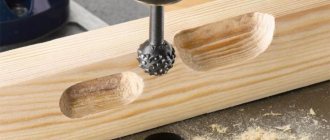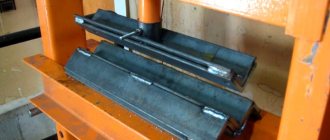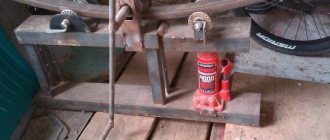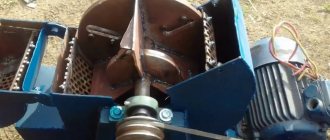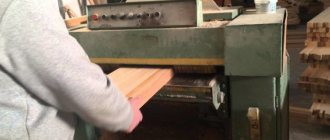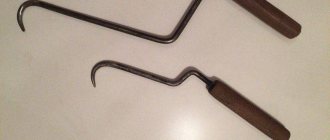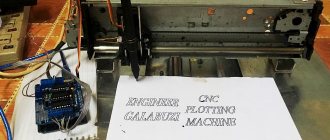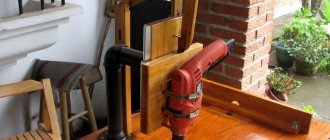Machine for bending reinforcement SGA-1.
Photo by PromStroyMash From the moment man learned to process metals and create various structures from them, the problem of expanding the scale of production became acute. Today, the metalworking industry offers us many equipment options for fast and convenient work in enterprises. The main task of such machines is not only to improve the quality of the final product, but also to speed up the work process and improve conditions for the machine operator . Let's take a closer look at this type of machine, such as mechanisms for bending fittings and pipes, namely SGA-1.
Let's analyze its pros and cons, advantages (in comparison with similar devices), operating modes, components and consumables that are used in working with metal. We will also consider the technical characteristics and list which factories produce these machines and whether it is worth buying used equipment.
Advantages of the bar bending machine
Considering the active development of scientific and technological progress, you need to understand that most of the innovations produced by manufacturers around the world are modifications of simple mechanisms that were discovered more than a century ago.
A logical question immediately arises : is it as rational to use machines for bending fittings and pipes as manufacturers claim?
In order to answer this question, you need to turn to statistics on production volumes before 1915, because it was at that moment that automatic and semi-automatic machines for bending metals began to be introduced on a large scale. It’s hard to believe, but until this moment, metal products were bent by hand, and sometimes, in order to process a reinforcement bar, the efforts of 3 or even 4 people were required.
This leads to the first advantage, namely acceleration of the work process and increase in production volumes.
If the machine is so efficient, then it must have some kind of disadvantage, for example, large dimensions or a complex connection diagram. Despite the fact that the device belongs to the budget category, its transportation, installation and connections do not cause any inconvenience , the diagrams are intuitive, and if this is not enough, a connection diagram and instructions are included with the machine.
The second advantage is ease of transportation and installation.
Everything is set up, there is enough material, electricity is supplied. The mechanism is equipped with a control panel, with which you can control the operating mode, set various parameters and stop the product preparation process at any time. Therefore, operating the machine is not difficult at all.
Machine for bending reinforcement SGA-1. Production - Russia. Photo VseInstruments.ru
The third plus is ease of use and ease of use.
It is also worth noting the economic factor. Most modern machines with high power consume enormous amounts of energy, however, their efficiency does not increase from this. The SGA-1 model is made taking into account this factor and does not consume electricity above normal .
The fourth plus is savings.
Another undeniable advantage is the use of a worm gear . This factor extends the life of the device and reduces the chance of failure of the feed mechanism.
Do-it-yourself manual machine for bending reinforcement.
Almost no construction is complete without concrete work, and where there is concrete, there is reinforcement. Build a foundation, pour a ceiling, install an armored belt in an aerated concrete house. All these works involve the use of reinforcement, with which reinforced concrete structures are reinforced.
Beginning developers have a question: how to correctly bend the reinforcement so that it does not lose its strength characteristics.
Wrong homemade reinforcement bender
While a rod with a diameter of 6-8 mm can be bent “over the knee,” it is difficult to bend reinforcement with a larger diameter by hand. And most importantly, the quality of such a product will be below any criticism.
Also, you should not resort to such “folk methods” of bending reinforcement with your own hands as:
- Sawing with a grinder the place where the reinforcement is bent;
- Warming up the bend area with an open flame, in a fire or with a blowtorch.
These methods, due to mechanical and thermal treatment of the metal, lead to a decrease in its strength characteristics at the bend. This can subsequently lead to destruction of the reinforcement under the influence of loads.
Therefore (unless there are other instructions for the project), it is necessary to bend “cold”; bending the rod at an acute angle is not allowed.
The reinforcement should be bent under a certain radius of curvature, which depends on its diameter.
To bend reinforcement, devices such as machines with mechanical or manual drive are used. Due to the high cost, mechanically driven machines are not widely used among self-builders.
The price of branded manually driven reinforcement benders is also steep.
Therefore, FORUMHOUSE users prefer homemade devices to purchased products. As practice shows, such a device for bending reinforcement with your own hands is within the capabilities of anyone. To make it, we use cuttings of water pipes, channels, angles, bolts, scraps of rolled metal and other “unnecessary rubbish” that can be found in the bins of any home craftsman. The cost of such products ranges from 50 to 500 rubles, while the cost of a reinforcement bender purchased in a store can be 3-5 and 10 thousand rubles. The benefit is obvious. Let's roll up our sleeves and get to work.
How to make a reinforcement bender with your own hands
The simplest and most affordable way to independently bend rods with a diameter of no more than 6-8 mm (making frames, clamps, etc.) is to drive three thick sections of it into a log. Moreover, two pieces are driven in along one line, and the third is driven in between them, with an indentation from the center line by the thickness of the reinforcement that is supposed to be bent.
Another method is to attach/weld two corners with a bottom stop to the corner of the cabin/post, and bend the reinforcement between them.
Or this adaptation option: weld bolts to the fence post.
Despite the simplicity of these homemade devices, they are not very convenient to work with, and they are best suited for the manufacture of U-shaped products, clamps and frames.
DIY machine for bending reinforcement.
Therefore, the further development of the device is the production of a full-fledged homemade reinforcement bender operating in a horizontal plane.
The principle of operation of such a bender is as follows: the rod is fixed between the thrust element (angle) and the central fixed metal pin. Next, we install the rotary unit, which is equipped with a bending pin and a long lever (pipe).
When the bending unit for reinforcement is rotated, due to the force generated on the lever, the reinforcing bar is bent around the central metal pin to the required angle.
On such a machine, you can manually bend reinforcement with a diameter of up to 14 mm, and by strengthening the structure and installing a long lever (about 2 meters), reinforcement with a diameter of 16 mm will “submit” to you.
A manual reinforcement bender can be made with your own hands in a couple of hours. Any developer who has at least once worked on such a device will never return to bending reinforcement with his own hands, holding it in a vice.
Here is one of the options for making such a reinforcement bender according to the “recipe” of a forum member with the nickname Konstantin Ya.:
Konstantin Y. FORUMHOUSE user
The bed is the 12th or 14th channel 1 meter long. We weld the channel to two supports (metal pipes) driven into the ground. To support the reinforcement, we weld two corners to the upper flange of the channel. The lever is two pipes welded at an angle of 90 degrees. An axis passes through the vertical pipe; we put an extension 1.2 meters long on the horizontal pipe. This increases the force on the lever. We weld a corner on top of the lever, thanks to which the end of the reinforcement clings when it is bent. The corner should be flush with the top flange of the channel.
The forum member made the axle from a metal rod with a diameter of 30 mm. The lower part is squared. This will prevent the axle from turning or falling out, because the lower hole in the channel is also cut square. The upper end of the axle protrudes above the upper flange of the channel. The reinforcement is bent around it (let's look at this simple drawing):
Konstantin Y. FORUMHOUSE user
To make the reinforcement bender, I spent 3 hours doing everything, including welding work. I have already bent 3 tons of reinforcement on it. Calmly, alone, I bend rebar with a diameter of 14 mm. I am completely satisfied with the device for bending reinforcement, because... Before making it, I broke a good powerful vice - I bent rods with a diameter of 12 mm on them, putting a pipe on them.
Vincenzo FORUMHOUSE user
My “unit” is somewhat simpler. The bed is channel No. 10-12. To make the “legs” I took reinforcement with a diameter of 20 mm. Corners – size 50x4. I bent the “twelfth” reinforcement without any problems.
Do-it-yourself reinforcement bender from a corner
Considering the homemade products of forum members, we can say that reinforcement bending based on corners has become the most widespread.
Such a device for bending rods impresses with the simplicity of its manufacture, availability of materials and low cost. We offer you a drawing of a reinforcement bender:
A device according to this scheme can be made even without a welding machine, making do with connections using bolts and nuts. But the presence of a welding machine significantly expands the possibilities of making a reinforcement bender.
i-vUser FORUMHOUSE
During construction, I had a question about how to bend the reinforcement. After studying the forum, I chose the simplest option - two corners connected by a bolt. Because Since I needed to bend rods no more than 8 mm in diameter, I did not strengthen the structure. I welded a piece of pipe with a diameter of 20 mm to one corner. The corners were connected with an M10 bolt. I screwed a nut onto it, and then secured the structure to an improvised frame - a piece of thick plywood. Took 1.5 hours to make. It took exactly the same amount of time to produce 90 frames measuring 150x750 mm.
Despite the popularity of this reinforcement bender design, members of the forum go further along the path of modernization and improvement of the mechanism. Of particular interest is a device for bending reinforcement with your own hands, made by max68.2011.
Channel No. 10 is used as a basis, because It is convenient to attach it to a piece of timber. You will also need bearings, corners 25x25 mm 50 mm long, which are welded to the side of the channel. 2 holes are drilled on the side, an M10x1.5 thread is cut (for thin fittings).
The bending axes are M16x2 bolts. One bolt is welded to the channel. We weld the second bolt to the earring (swivel unit), for which a spring from a Gazelle is used. The lever handle is a pipe with a diameter of 34 mm and a length of 300 mm. To increase the force on the lever, you can put an extension on a short pipe - a long pipe of a larger (put on the outside) or smaller (inserted inside) diameter.
The use of a bearing in the bending unit allows the reinforcement to slide along the rolling. In the device itself, the reinforcement is rigid. This increases the accuracy of product manufacturing.
It is worth focusing on the point why the bender needs a set of bushings of different diameters, 4 cm long.
According to SP 52-101-2003 “Concrete and reinforced concrete structures without prestressing reinforcement”, when bending reinforcement, the minimum bending diameter of an individual rod must be such as to avoid destruction or splitting of concrete inside the bend of the reinforcing bar and its destruction at the bend point. Hence, the minimum diameter of the mandrel when bending reinforcement depends on the diameter of the rod. For clarity, all values are summarized in the following table:
Thanks to the set of bushings, you can flexibly select the bending radius of the reinforcement depending on its diameter.
Over time, the max68.2011 reinforcement bender has undergone changes. Now in appearance it is no different from industrial products.
Also, many forum members are interested in the question: how to calculate the length of the reinforcement rod when making frames. After all, a simple addition of values, if the frame should be 50x20 + 2 ears of 40 mm each, then purely theoretically, the length of the rod should be equal to 50 + 50 + 20 + 20 + 4 + 4 = 148 cm. But, taking into account the radii of the bends, this figure is incorrect . Here is a possible way out of this situation:
Hant72FORUMHOUSE user
From my own practice, I can say that I add an additional 5 mm to each bend. This depends on the diameter of the reinforcement. You need to make a frame 50x20x4 (ears) from tens of reinforcement, add: 4.5+50.5+20.5+50.5+20.5+4.5. The total length of the rod is = 151 cm.
In conclusion, we’ll tell you about another “secret” of forum members, used when bending reinforcement. You need to fix the reinforcement bender on a long wooden table and mark it in advance by screwing in screws and marking with a marker the values that correspond to the mounting size of the rod rotation in the bending unit. Thus, you can save yourself from the need to use a tape measure every time, measuring the required length of the rod.
After reading the topics How to bend reinforcement and Reinforcement bending with your own hands in 1.5 hours, you will get acquainted with various options for making this device yourself (drawings, photos, instructions are attached). We also suggest finding out the answer to the question: how to properly reinforce the foundation in the corners. FORUMHOUSE also recommends learning all the secrets of welding and reading an article about the features of cold forging. And this video will help you understand how to properly carry out reinforcement work.
Functions
The SGA-1 device has two operating mechanisms, namely mechanical and automatic. In the first version of work, the entire process is completely controlled by the operator, and in the second case, the performer only feeds the workpieces and removes the finished products.
This is interesting: G-40 - machine for bending reinforcement
For bending what kind of reinforcement
Using SGA-1 you can process such types of reinforcement as :
- working;
- constructive;
- installation;
- anchor
Examples of bending possibilities
Maximum cross-section of a workpiece rod:
- A-I – 40 mm;
- A-II – 36 mm;
- A-III – 32 mm.
Let's summarize. The machine can work with reinforcement with a medium cross-sectional size, which is made of standard carbon and alloy steels. In principle, its power will not be enough to bend very hard metal rods, but most types of reinforcement are made from soft steels.
ATTENTION! Under no circumstances should you try to install two workpieces between the rollers at the same time, even if their total density is less than specified in the specifications for the machine. The fact is that the rollers are calculated taking into account the load on one point, and by installing two workpieces, you disrupt the operating mode, which leads to equipment failure.
Bending machine from scrap metal scraps
You can make a simple reinforcement bender with your own hands even from unnecessary scraps of metal that are lying around in scrap metal.
A version of this bender design was shared by the author of the YouTube channel Fawa Bros. We will take this as a basis.
The first step will be to manufacture the moving part of the structure.
We cut out a blank of the required shape from sheet metal. Then you need to drill a hole and attach by welding a section of a pin onto which a thrust roller made of a round pipe is placed. Screw the nut onto the stud.
We weld the bearing to the bottom of the workpiece.
A metal plate of rectangular or square shape is suitable for the base - whichever you prefer.
We drill mounting holes in it in the corners, and another one closer to the central part.
We install a previously made part with a bearing on the plate, and fix it with a steel round timber, in the upper part of which there is a groove so that workpieces can be inserted.
The lower part of the round steel will need to be welded to the base of the reinforcement bender.
Next, we weld a piece of profile pipe to the moving part, onto which the lever handle will be placed.
We weld a piece of a square rod to the metal plate, on top of which we need to weld an elongated coupling. We screw a bolt into it, which in this case serves as a travel limiter for the moving part.
At the last stage, all that remains is to make the handle and install it.
The handle additionally has a movable stop, with which you can adjust the bending length of the workpiece.
How to make a compact device for bending reinforcement with your own hands is shown in all details in the author's video.
DIY Tool | Make A The Simplest Metal Bender | Homemade Metal Bending Tool
As in previous cases, the homemade product turned out to be simple and easy to use. The square plate is attached to the table using bolts, and you can immediately start working.
Specifications
Features of the bending machine for reinforcing steel SGA-1
- On the plate of the SGA-1 machine there is a funnel for removing scale with a flange for joining to the aspiration system;
- The bending disk is driven through a V-belt transmission from the engine;
- It is possible to perform simultaneous bending of several reinforcement bars;
- All spare parts for the machine are easily interchangeable.
Machine characteristics
- Power - 3 kW
- Maximum permissible diameter of fittings, mm. — from 10 to 32 mm (Rebar class GOST 5781-82 and 10884-94, A-240, A-400, A-500S, At-500)
- Internal bending radius, mm. — 20-55
- Dimensions LxHxW, cm - 79x69x68
- Weight, kg. - 380.
The machine can perform up to 8 bends per minute.
Machines and devices for bending reinforcement
In the process of development of construction technologies and metal processing methods, more than one machine for bending reinforcement was created. All such equipment works on the same principle; the difference between the models consists only in certain design features and the maximum diameter of the bending rod.
Any bending machine, including a homemade machine for bending reinforcement, works on the following principle: the rod is fixed between two rollers (central and thrust), and with the help of a third roller (bending), the reinforcement is bent at the required angle. Conveniently, the machine for bending metal reinforcement can bend a rod both to the left and to the right. The required bending radius is ensured by the thrust shaft, thanks to which the reinforcement does not deform along its entire length.
One of the options for a homemade machine, consisting of two parts - movable (lever) and fixed (base)
Drawing of the moving part
Fixed part drawing
An example of how ordinary nails can be used to quickly measure the distance between the bends of rods.
Machines designed for bending reinforcement, including those made by yourself, can be of two types:
- manual;
- with mechanical drive.
The main working element of mechanically driven machines is a rotating disk on which the bending and central fingers are fixed. There is a gap between these fingers, into which the rod to be bent is placed. The reinforcement placed in this gap rests at one end against a roller rigidly fixed to the device body. As the disc rotates, the bending pin acts on the reinforcement and bends it around the central shaft.
Manual bending machine AFACAN 16PT (price approximately 5,500 rubles). One of the models of this particular Turkish manufacturer was mentioned in the video at the beginning of this article
A specific machine for bending reinforcement, depending on its purpose, may belong to one of the following groups:
- light (for bending rods with a diameter of 3 to 20 mm);
- heavy (diameter of processed rods - from 20 to 40 mm);
- extra heavy (for fittings with a diameter of 40 to 90 mm).
Power driven equipment can be used to bend multiple rebar bars at the same time. Modern industry produces machines that can be used for bending rods whose diameter ranges from 3 to 90 mm. For those cases where it is necessary to bend reinforcement at different angles, it is best to use hydraulically driven equipment. Such a universal machine for bending reinforcement allows you to obtain a bending surface without cracks and folds, which can lead to the formation of internal stresses. This equipment also makes it possible to adjust the bending angle to 180 degrees.
On the modern market, you can optimally select a machine for bending various types of reinforcement, including portable ones, which are easy to use and affordable. Bending of reinforcement can be done either using special equipment or using a pipe bender, which is installed on ordinary workbenches.
You can make such bending devices yourself. However, they are used for bars with a diameter of no more than 14 mm and are not intended for cases where high productivity is required. Most often, such devices are used in private construction.
Another variation of the bending machine: a channel as a base, two angles, an axis of rotation and a handle
When choosing equipment for quick bending of reinforcement, two main factors should be taken into account: the maximum diameter of the rod that needs to be bent and the volume of work to be done. When bending a rod, its parts are subjected to different loads: the outer surface is subjected to tension, and the inner surface is subjected to compression.
If you choose the wrong equipment, then folds and cracks may form on the processed bar (or it will collapse under the influence of significant loads). To prevent this from happening, it is necessary to correctly select and configure bending equipment, as well as ensure reliable fixation of the reinforcement being processed.
Wiring diagrams
The machine consists of a support frame on which a plate and a gearbox with a special device are placed, which is responsible for bending parts from rods. The electronics are controlled using a pedal ; pressing it begins the process of closing the contacts. There are also clamps between which the part and the bending roller itself are installed.
Most often, in the SGA-1 machine, the bar for the thrust pins fails , since the walls between the compartments are quite thin. As a result of improper operating conditions, or processing of workpieces made of too hard metal, the walls may be damaged. The bending disk for reinforcement also suffers (for the same reason), although it can fail due to unbalance of the rotation axis.
In addition, for correct operation you need oil , which is poured into the gearbox, and the machine parts are lubricated with it. Without it, the worm shaft heats up and the efficiency of the entire working process drops.
Electrical control circuit
Kinematic diagram
Technology for performing work (option No. 2)
To make your own machine for bending small-diameter steel bars, you need to follow these instructions:
- Pieces 5 cm long are cut from corners with shelf sizes of 25 and 32 mm. The same actions are carried out with a square profile and reinforcement with a diameter of 12 mm.
- Two pieces of reinforcement are inserted inside the profile and welded.
- The corners are also connected to each other using a welding machine.
- The resulting blanks are welded and installed in the thrust part of the jack. The location of the punch should be carefully controlled, since horizontal deviations are unacceptable.
- A T-shaped frame needs to be made from a rectangular profile. The dimensions of this structural part of the equipment are as follows: height – 40 cm, width – 30 cm.
- You can ensure a stable position of the jack during bending using stops that need to be welded to the horizontal part of the frame.
- It is necessary to weld two corner pieces with a flange size of 25 mm onto the side of the frame. Hinges for the gates are attached to their surface, which will later act as stops. Calculate the distance between the end of the punch and the stops to match the diameter of the reinforcement that will be used in the future.
Bending machine drawing
Technical problems
FAQ.
Reverse does not change
For example, the reverse of a machine does not change . In order to solve this problem, you need to inspect the three-phase motor, and specifically test it in idle mode. If the same changes are observed at idle, then most likely the engine needs to be replaced or repaired.
Vibration
Machine SGA-1, used for bending reinforcement.
Photo by PromStroyMash Another common problem is machine vibration , even due to the absence of a workpiece. This may indicate that the motor is not running properly, or the main center axis is unbalanced, or the unit is not securely secured to the floor, or the pad between the unit and the floor is uneven or at an angle.
Other questions
It is also possible for the bent rollers to go beyond the working plane . In other words, the mechanism tends to bend the part outside the workbench. This problem is typical for machines that have a broken converter bus, that is, the breakdown occurred at the software level. The control panel does not convert commands properly, transmitting incorrect instructions and incorrect rotation and pressure coordinates to the mechanism.
Another type of such a breakdown is normal readings on the control panel and incorrect operation of the mechanism in reality. That is, on the control panel the operator will observe that the process is proceeding according to the standard algorithm, and the workpiece will not bend or will bend incorrectly. In this case, you need to inspect the operating system of the machine. You may need to change the software or install it again.
Machine SGA-1 for bending reinforcement. Photo Machine World
Another common problem that can be either hardware or mechanical related is workpiece flyout. In other words, when installing the workpiece, it does not bend properly, but flies off the rollers. The reasons may be the following: the first and most common is a violation of the integrity of the fastener walls; the second is the failure of the clamping rollers, the third reason is violations in the software shell, which provoke too fast or incorrect operation of the mechanism. Before starting work, it is recommended to remove the clamping bending rollers and the central shaft and reinsert them in order to inspect the grooves and the integrity of the entire system, and diagnose the device for damage.
IMPORTANT! Machine tools are classified as potentially hazardous mechanisms. Therefore, it is recommended to contact specialists rather than repair them on your own, even if the contractor has experience. After all, a breakdown of a mechanism can result in more than just a failure in the entire electronic network. loss of time, reduction in production volumes, but also injury to the machine operator.
Finally, the right reinforcement bender. Do it yourself
What should be the correct reinforcement bender? Of course, easy to use and functional. In this review, the author shows how to make such a device with your own hands.
The main materials for making a homemade reinforcement bender are bearings and a profile pipe. You will also need pieces of angle and round pipe.
The advantage of this bender is its versatility. Using different equipment, you can perform different operations.
It is worth noting that this reinforcement bender can bend not only reinforcement and round bars of different diameters, but also square bars and metal strips. Making such a device is very simple.
We also recommend reading a review on the topic: how to make a manual reinforcement bender from a worn support bearing.
Main stages of work
The first step is to make a housing for the bearing. To do this, the master cuts a piece of a round pipe and cuts out part of the wall.
We put the workpiece on the bearing, tighten it with a clamp, and scald it. We clean the weld seam with a grinder.
Next, the author welds two pieces of angle to the inner race of the bearing. You need to install them in such a way that you get a square profile.
Manufacturing plants
- Mashstroykonstruktsiya
- PromStroyMash
- RusInStroy
- Gigant (Machine tool company)
This is interesting: G-40 - machine for bending reinforcement
All production facilities of the above companies are located in Russia. This is due to the low price and fast delivery speed. Nevertheless, the SGA series is perhaps the only one that has found application abroad.
These certified manufacturers have at their disposal all the necessary documents and certificates for sale; their machines undergo a quality control procedure and suitability for work.
ATTENTION! If you purchase used equipment and the seller refuses to provide certificates or documents that confirm the fact that the machine was purchased at the factory, most likely you are dealing with a fake.
Spare parts, gears, repair kits, repairs
The same applies to components. Manufacturers do not just focus on purchasing factory spare parts. Check out the contact block on our website, which contains trusted manufacturers and component suppliers to be sure of the correct operation of the purchased machines.
Companies involved in the repair and service of machine tools are presented here.
Let's summarize the review. The SGA-1 machine is a universal mechanism for working with fittings for various purposes and structures . Its price and characteristics will allow you to start production from scratch and receive a net profit in just a few months, taking into account the costs of electricity and maintenance. Operation, installation, and transportation of the machine does not bring additional inconvenience if you order the equipment from certified manufacturers that were listed in the article.
Do not neglect diagnostics and inspection of equipment, since one incorrectly configured machine can damage the entire electronic network if it is included in the production chain or disable nearby equipment through mechanical damage.

